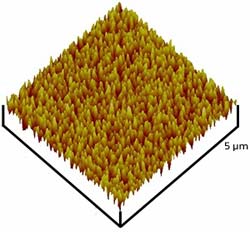Materials chemistry: When additives are good

Magnetic columnar iron–cobalt–nickel nanofilm with high permeability from suitable additives<br>Copyright : Bao-Yu Zong<br>
Soft magnetic materials can be easily magnetized and demagnetized. They are widely used in microwave devices, such as absorption of electromagnetic radiations.
Developers tend to use thin films of soft magnetic materials, as opposed to their bulk form, in mobile applications, such as cell phones and laptops, as well as military applications, such as stealth aircrafts. However, the conventional approach to making soft magnetic films requires a high vacuum environment, which is expensive and time-consuming. Moreover, the usual fabrication system is not suitable for the preparation of large sheet films, thereby limiting its application in manufacturing the soft magnetic materials for microwave absorption.
Bao-Yu Zong at the A*STAR Data Storage Institute and co-workers1 have now demonstrated the viability of fabricating soft magnetic thin films through electrodeposition, a plating technique that is scalable and can be performed at room temperature. The approach is not only simpler and cheaper to operate, but also versatile enough for making a wide range of soft magnetic materials for microwave applications.
The researchers chose to work with iron–cobalt–nickel alloy, a soft magnetic material with low permeability, high coercivity and other less-than-ideal properties. They added small amounts of organic compounds, including dimethylamine borane and sodium dodecyl sulfate, to the plating solution prior to deposition. The resulting thin films had much higher permeability and lower coercivity, which make them more desirable for microwave applications. The researchers suggest that the additives might have prevented iron from oxidizing during electrodeposition, thereby improving the quality of thin films obtained.
Zong and his team also explored the effect of adding inorganic compounds, such as aluminum potassium sulfate, to the plating solution. They detected an increased resistivity in the thin films — a result that is likely to be a consequence of the change in morphology of the material; that is, the shape of the nanoparticles changed from common granular to columnar (see image), as revealed by atomic force microscopy. The iron–cobalt–nickel thin films also exhibit strong microwave absorption in comparison to ordinary magnetic films. These unique properties are perfect for high-frequency microwave applications, including magnetic data storage, portable wireless and biotechnology devices.
The researchers have high hopes that their approach is applicable to the fabrication of a wide range of soft magnetic materials. “Our technique is cost-effective and scalable. We can create soft magnetic thin films on different size and type of substrates,” says Zong. “In a subsequent step, we hope to transfer this methodology to related industrial companies.”
The A*STAR-affiliated researchers contributing to this research are from the A*STAR Data Storage Institute
Media Contact
All latest news from the category: Materials Sciences
Materials management deals with the research, development, manufacturing and processing of raw and industrial materials. Key aspects here are biological and medical issues, which play an increasingly important role in this field.
innovations-report offers in-depth articles related to the development and application of materials and the structure and properties of new materials.
Newest articles

Silicon Carbide Innovation Alliance to drive industrial-scale semiconductor work
Known for its ability to withstand extreme environments and high voltages, silicon carbide (SiC) is a semiconducting material made up of silicon and carbon atoms arranged into crystals that is…

New SPECT/CT technique shows impressive biomarker identification
…offers increased access for prostate cancer patients. A novel SPECT/CT acquisition method can accurately detect radiopharmaceutical biodistribution in a convenient manner for prostate cancer patients, opening the door for more…

How 3D printers can give robots a soft touch
Soft skin coverings and touch sensors have emerged as a promising feature for robots that are both safer and more intuitive for human interaction, but they are expensive and difficult…





















